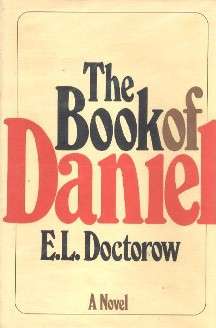The Book of Daniel (novel)
 First edition | |
| Author | E. L. Doctorow |
|---|---|
| Original title | The Book of Daniel |
| Country | US |
| Language | English |
| Publisher | Random House |
Publication date | 1971 |
| Media type | Hardcover |
| Pages | 303 |
| ISBN | 978-0-8129-7817-9 |
| OCLC | 141385012 |
| LC Class | PS3554.O3 B6 2007 |
The Book of Daniel (1971) is semi-historical novel by E. L. Doctorow, loosely based on the lives, trial and execution of Ethel and Julius Rosenberg. Doctorow tells the story of Paul and Rochelle Isaacson (corollaries to the Rosenbergs) through the persons of their older son, Daniel, and his sister, Susan, who are college students deeply involved in 1960s politics.
Plot summary
Writing his doctoral thesis ('The Book of Daniel'), Daniel investigates the background to his parents' conviction and execution with his adoptive parents (the Lewins). The dénouement is the revisiting, in flashback, of the death of his parents, Rochelle and Paul Isaacson, and, in due course, the death from nervous disorder (and attempted suicide) of his sister Susan. The novel closes as the library in which Daniel is working is closed by student protests. Doctorow closes his novel with a parody of lines from Chapter 12 of the Biblical Book of Daniel.
The book is written in four parts, and in each Daniel is the principal narrator; the narrative moves fluidly and rapidly between 1967 ('the present') and flashback (to the late 40s/early 50s), and between first and third person:
- 1. Memorial Day – Opens, in 1967, with Daniel, his young wife, Phyllis and baby Paul, walking to the sanatorium to see Susan; closes with the dropping of atom bomb in Japan
- 2. Halloween – closes with the lawyer, Ascher, telling Daniel and Susan of the forthcoming start of the Isaacsons' trial
- 3. Starfish – closes with Daniel's bruising involvement in an anti-draft march, while his sister (the starfish of the title) is lying dying from complications following her suicide attempt.
- Daniel says to Phyllis through broken teeth '...It looks worse than it is. There was nothing to it. It is a lot easier to be a revolutionary nowadays than it used to be.'
- 4 Christmas – recalls the closing moments of the trial, including the key evidence from their co-accused, Selig Mindish; Daniel's later search for, and discovery of Mindish, now senile, in Disneyland; and the funerals of Daniel's parents and his sister Susan.
Film, TV or theatrical adaptations
The book was adapted as a film, Daniel (1983), directed by Sidney Lumet. Lumet somewhat changes the emphasis of the novel, to concentrate more on the 1940s left-wing politics of the parents. This was an era of which Lumet had close personal experience – the film is generally less well-regarded than the book.
Allusions/references to history, geography and current science
Neither the book nor the film make direct reference to the Rosenberg events (though Lumet did claim that the execution scene was 'as it happened').
The introduction of Susan as the younger child (rather than the second son of the Rosenbergs), and her lingering death, appears to be an attempt to distance the novel from being considered biographical.
Other key differences include – Rochelle is a college graduate, Paul is not; this is the reverse of the Rosenbergs. Mindish appears to be a fusion of two historical figures, Morton Sobell and David Greenglass.
A key scene (in part 1), is the family's attendance at the Robeson concert at Peekskill (1949); in the novel Paul leaves the bus to argue with the right-wing protesters and is violently set upon by them.
Another key scene has Daniel taking part in the 1967 anti-Vietnam war march on the Pentagon.
References
- Lehmann-Haupt, Christopher: "'The Book of Daniel'", Books of The Times, New York Times, 6 July 1971.
- Naomi Morgenstern, "The Primal Scene in the Public Domain: E.L. Doctorow’s 'The Book of Daniel'", Studies in the Novel, Vol 35, 2003.
- Rasmussen, Eric Dean. "E. L. Doctorow's Vicious Eroticism: Dangerous Affect in The Book of Daniel", symplokē 18.1–2. (2011): 190–219.